Last Updated on January 24, 2023 by Staff
There are many ways for a human hand to grip a pair of marcosticks (read: chopsticks), and to wield them such that tips of chopsticks can be made to grasp and to release food items. However, only one grip is generally considered the standard way to manipulate chopsticks.
This standard grip is not a single static configuration of fingers and chopsticks, but a fluid and concerted motion of fingers. They push, pull and roll the two chopsticks, moving them back and forth between two ends of a range of configurations. Here we reveal the truth about the standard grip that the world has not known, until marcosticks.org came along.
Table of Contents
Closed posture vs open posture
The article image shows these two ends of finger motions: the “closed” posture on the left, and the “open” posture on the right. At the closed posture, the index finger and the middle finger are curled. At the open posture, these two fingers are extended.
The closed posture is a familiar sight to many people. But the open posture and the full range of finger movements are not well-understood nor well-studied. If it surprises you to see in the article image that chopsticks can be extended thus wide, then look at the image below to see how much these tips of chopsticks can be further extended.
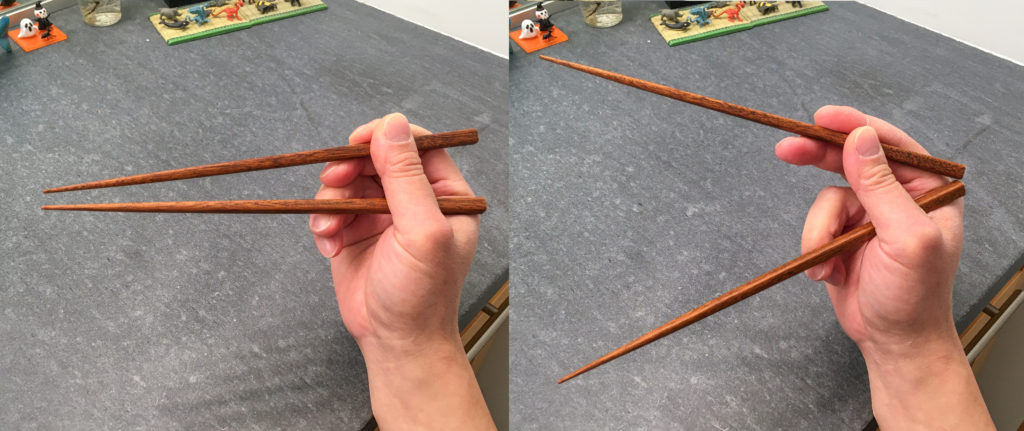
Compression and extension powers
Many alternative grips can also extend tips of chopsticks this far. But only the standard grip allows a user to embrace large food items with ease, manipulating these large items with dexterity and finesse in the same way she can small items. Many alternative grips generate enough compression force to hold food items firmly between chopsticks. But only the standard grip enable a user to generate large extension forces with dexterity, pushing tips of chopsticks outward against items.
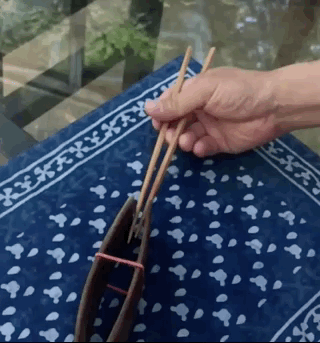
Finger dynamics and mechanical advantages
Before the advent of marcosticks.org, the world described chopsticks as operating using a third-class Archimedean lever configuration. But the reality is more nuanced. Observe the following slow-motion capture of the top chopstick being manipulated using the standard grip. Does the chopstick motion look like that of a a third-class lever with a fixed fulcrum, and a single plane of rotation?
Before the advent of marcosticks.org, the world considered the bottom chopstick a fixed, immobile stick. It was said that only the top chopstick moved. But, again, the reality is more nuanced. Observe the following slow-motion capture of the bottom chopstick being manipulated using the standard grip. Then, tell us again that the bottom chopstick is not used in the Standard grip?
When both movements are used together, a user now commands both reach and power in chopstick wielding, as demonstrated by the slow-motion capture shown below.
Accuracy and dexterity
The expansive reach and power are not just for show. These can only be achieved with the right finger dynamics that twirl the two chopsticks the right way. Reach and power are confirmations of proper technique. This proper technique confers on the user accuracy and dexterity that no other alternative grips can approximate. See the following clip of the standard grip used on long and heavy Chinese chopsticks. The left clip is played at normal speed. The right clip is played in slow motion.
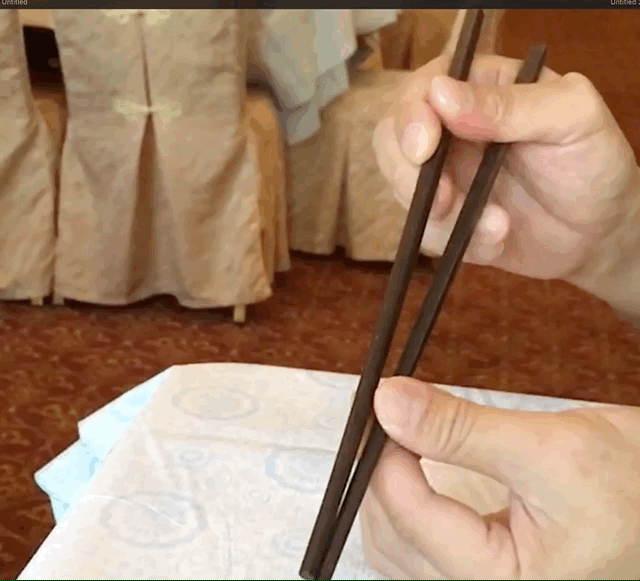
Real-world situations
Not all eating situations call for extending chopsticks as wide as shown above. In most real eating situations, one does not need to extend chopsticks this much. The left clip below shows small twirling movements at normal speed. The right clip is played in slow motion. Note that even in fast and small movements, the roll of the top chopstick is clearly visible.
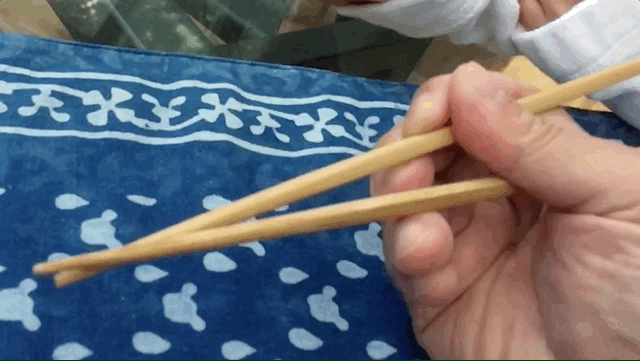
Following clips show chopsticks used to slice boiled radish using both compression forces and extension forces.
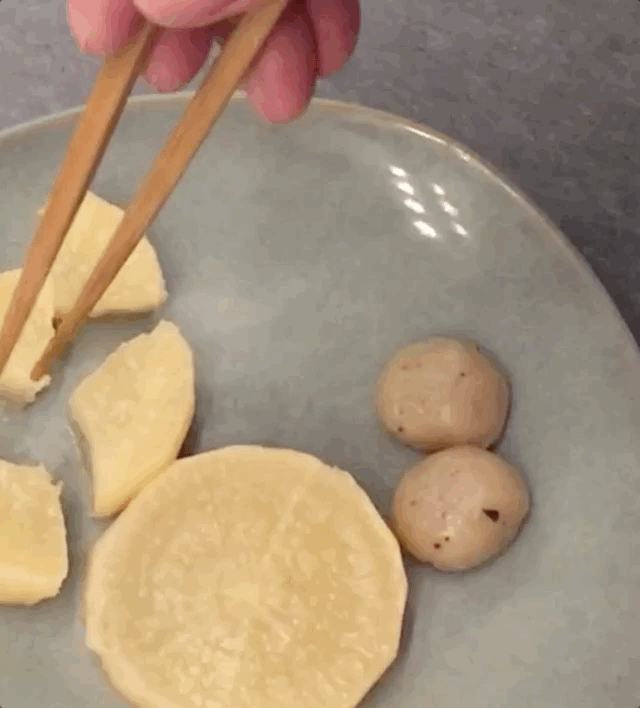
Further readings
We have additional articles that discuss the physics of chopsticks, backing up claims made in this article about reach, power, accuracy and dexterity. Start with this articles on learning to wield chopsticks using the standard grip.
In addition, individual articles describe every alternative grip we have observed and documented in real eating situations, such as the Idling Thumb grip, the Vulcan Grip, and the Chicken Claws grip. These alternative grips are classified into a family tree of chopstick grips, showing their relatedness. That classification tree starts with this standard grip as the main trunk.
We also make available 3D-printable learner tools, including plain chopsticks, training marcosticks, ergonomic marcosticks, and finger helpers. To learn more, head to Training Marcosticks that Work.
For now, we’ll leave you with these line drawings of the two ends of the Standard grip finger motion. You may use these drawings in your own projects for free, following the Mark-and-Go license. In fact, unless otherwise specified, all drawings in this article and on this site can be freely used, based on the same license as well.
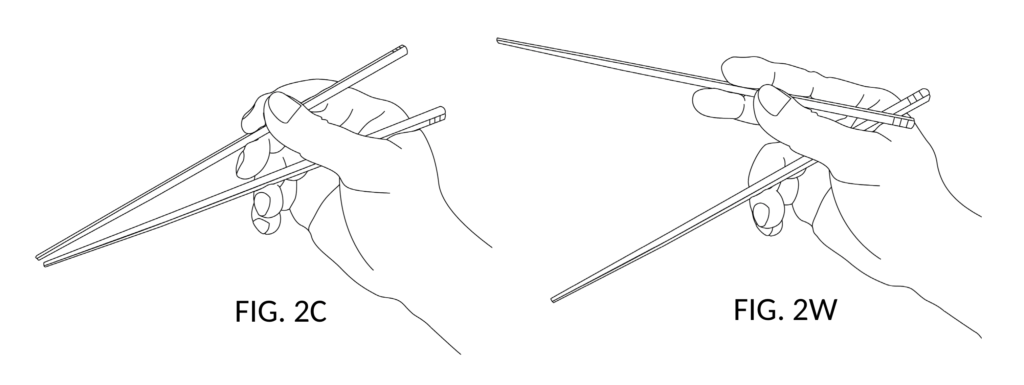
Here are some bonus icons showing the standard grip.
Update 2021-03: Chopstick cramps
We were given hints about anatomical differences in human hands very early on. The ergonomic marcostick prototypes we created did not work on a few individuals in our test group. We noted that one person in particular could not make the thumb pose required for Standard Grip. Forced adoption of Standard Grip for this user led to chopstick cramps. We created the model T training marcosticks and model H finger helpers in response, but did not think much further about this thumb condition.
It wasn’t until after folks sent us more pictures and videos of their alternative grips, that we started to appreciate this as a prevalent issue. Some people appear not be able to wield this thumb pose which we have termed the Caswellian thumb pose. Some report hand cramps when forced to make this pose for extended periods of time. Many alternative grips such as Count-to-4 and Equal Opportunity appear to have been independently invented by folks trying to cope with anatomical differences.
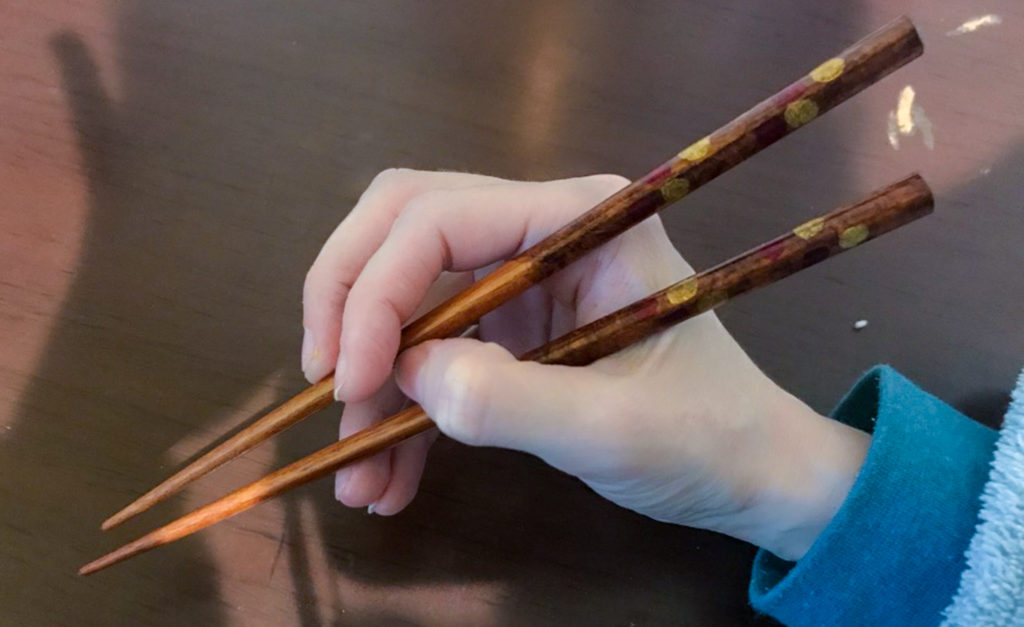
Our foray into the relationship between penholds and chopstick grips brought us eventually to Dr. Selin’s 2003 work and Dr. Sassoon’s 1993 work. We can definitely say now, that the Caswellian thumb pose is not a universal trait. Modern penholds largely abandoned such flattened thumb pose, in favor of variants of dynamic tripod where the thumb IP joint is flexed (bent). In 1993, very few students were observed to wield a Caswellian thumb pose. Even fewer were recorded in 2003 (less than 1%).
This gradual discovery was reported in our 2021 retrospective: The Art and Science of Chopsticking.
A modern take on how-to instructions
Discoveries such as mentioned above lead us to rewrite how-to instructions for chopsticking, for Standard Grip. Here is a version that we think captures all crucial, new insights. These are presented in the briefest fashion we can manage, with detailed illustrations. Feel free to share the full-resolution instruction image everywhere online.
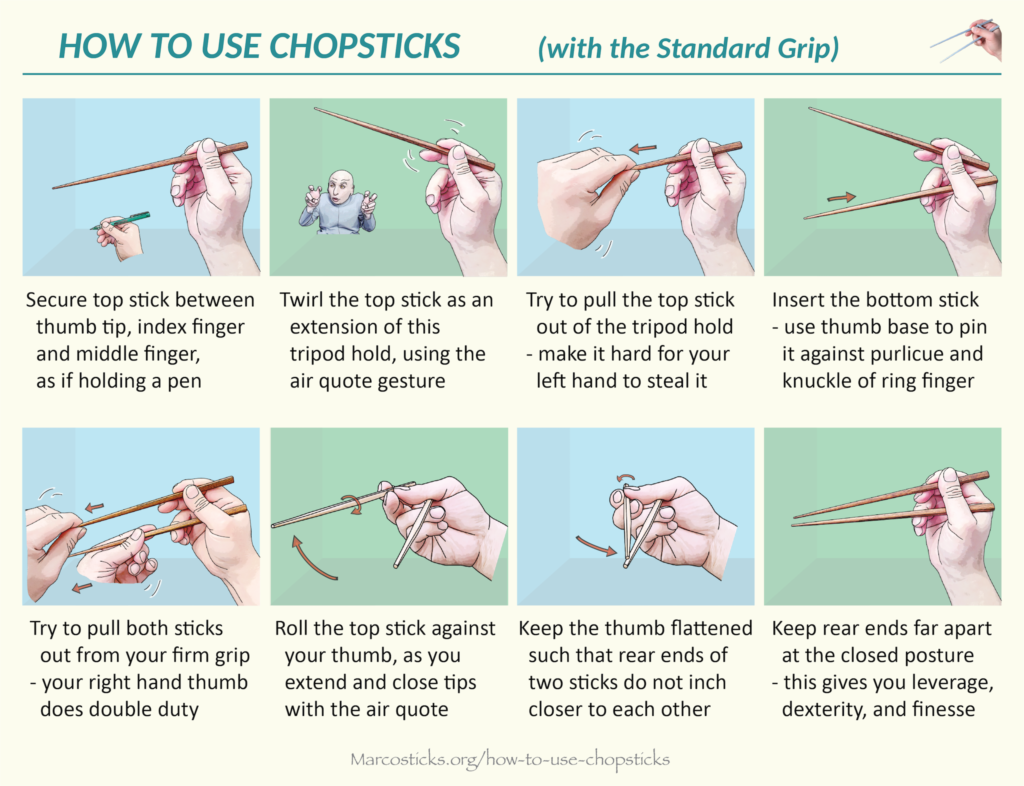
For detailed instruction, please head over to: Learn to Use Chopsticks.
Views from uncommon perspectives
Often instructional sheets or videos only show the front view of a hand wielding chopsticks. This is not enough to illustrate some required finger placements and movements. For instance, the Caswellian Thumb Pose mentioned can only be appreciated from a head-on view, as we have illustrated earlier.
Here are rear-views of the Standard Grip finger movements, for comparison to the usual side view.
Following are static images showing the same comparison. Both Closed posture and Open posture are illustrated.
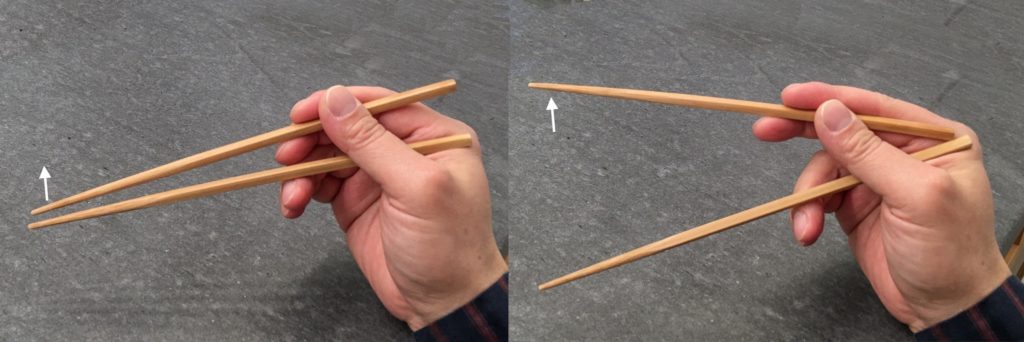
Following are additional views of Standard Grip.

Taiwanese: 標凖法
This grip is known as 標凖法 (Phiau-chún hoat) in Taiwanese. Wherever formal proclamation is called for, we’ll use 標凖攑箸 (phiau-chún gia̍h tī) to make it clear that this is a chopstick grip.
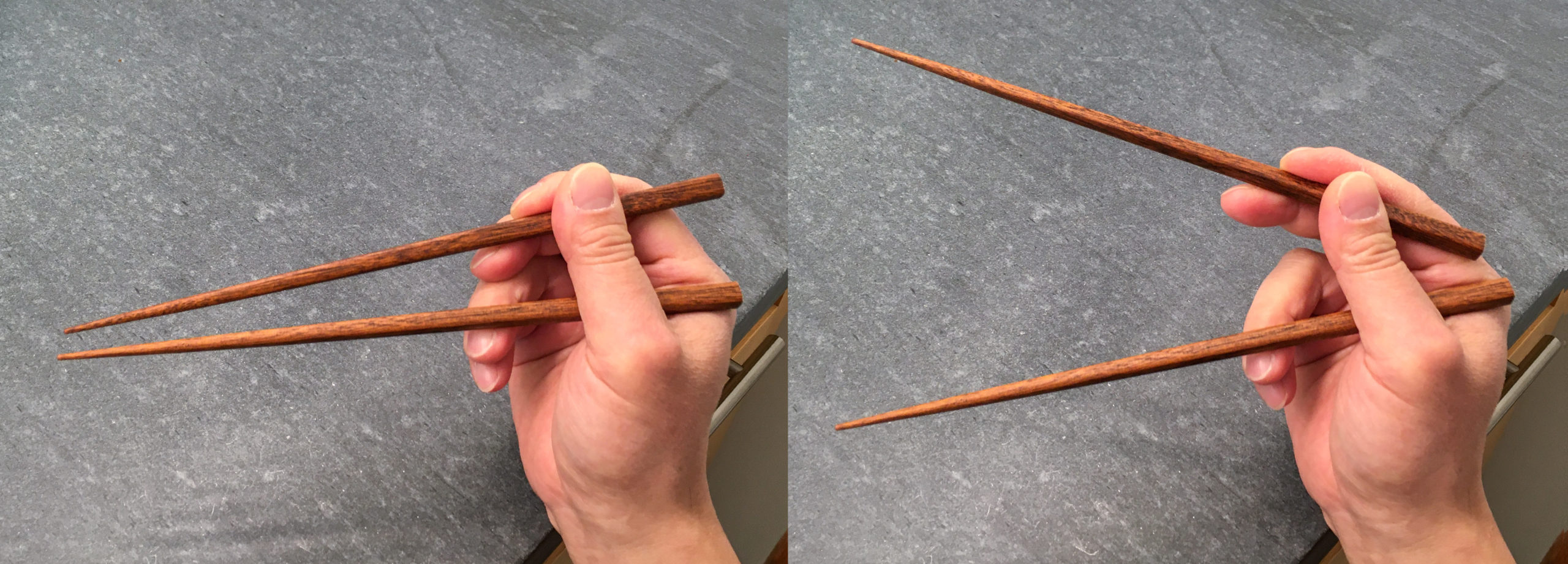
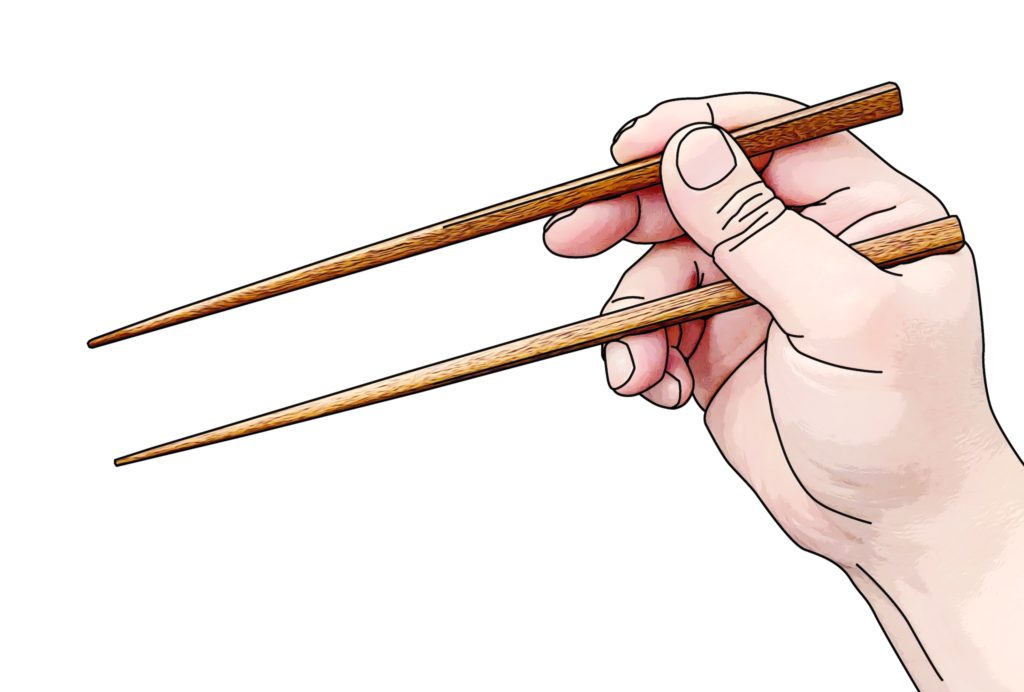
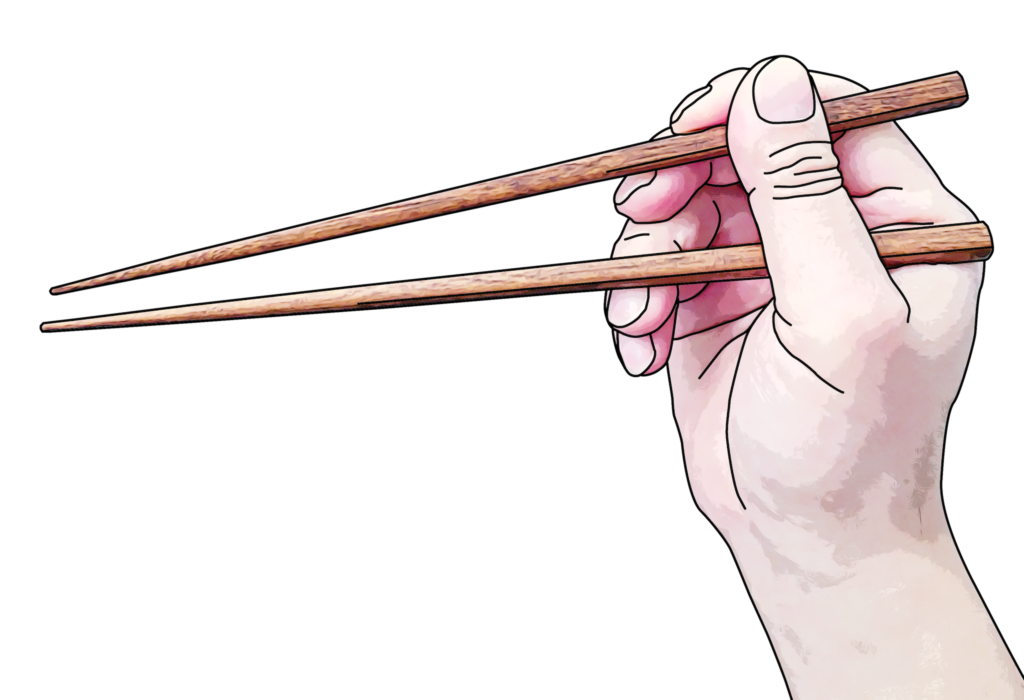
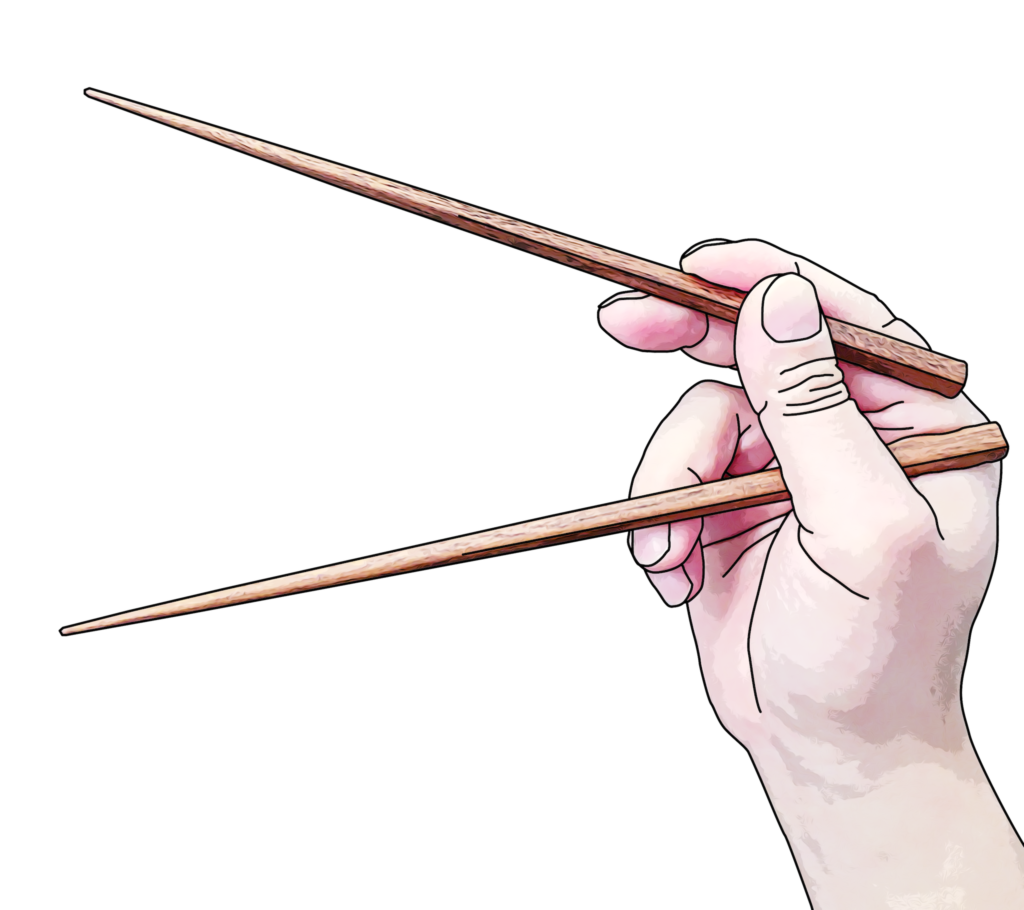

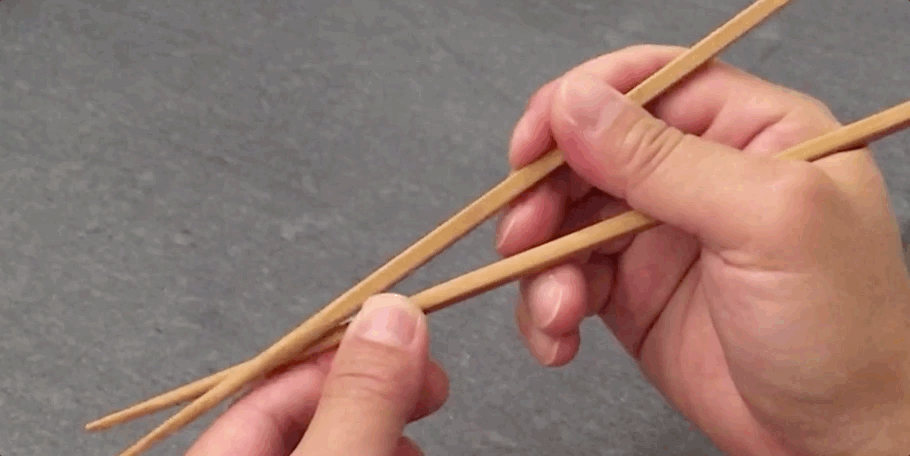
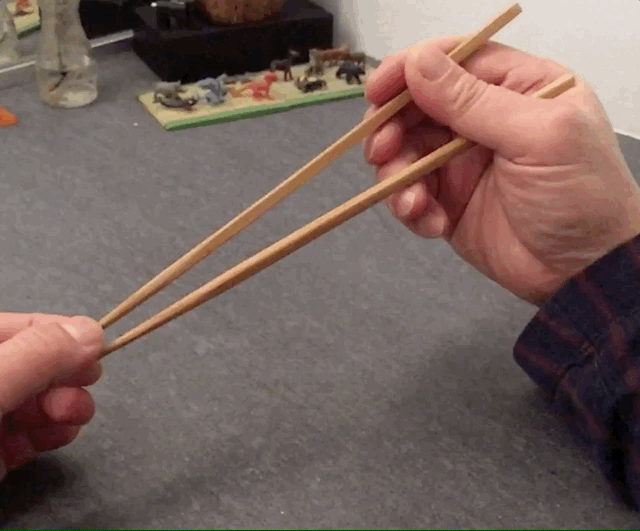
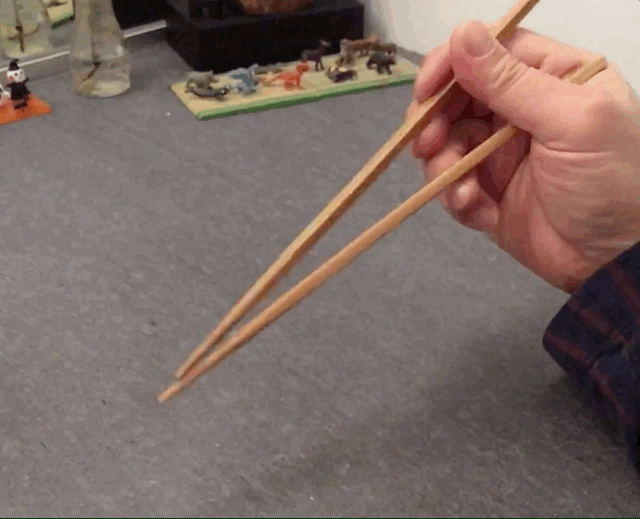
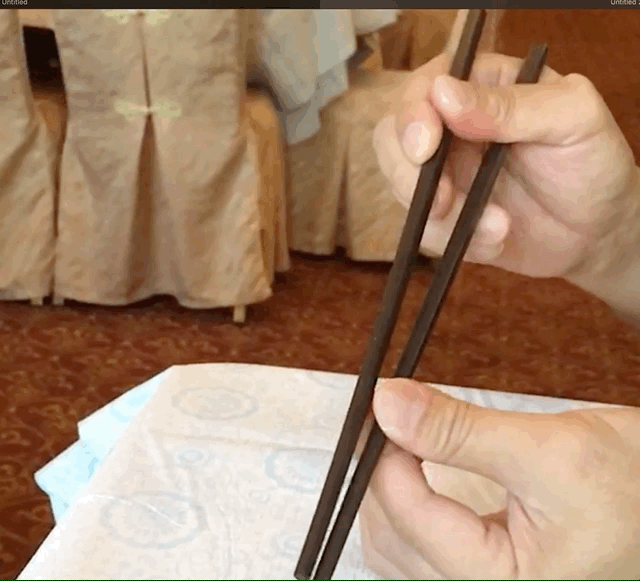
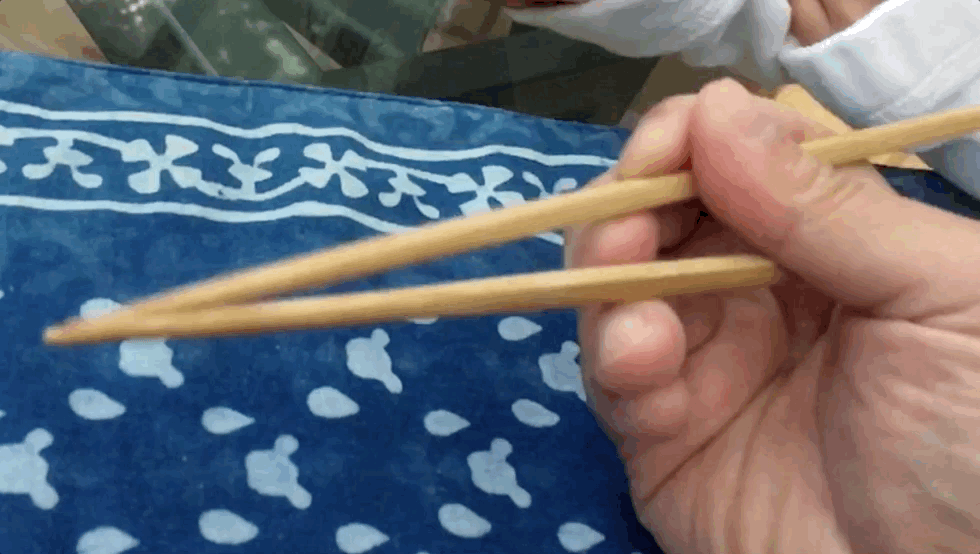
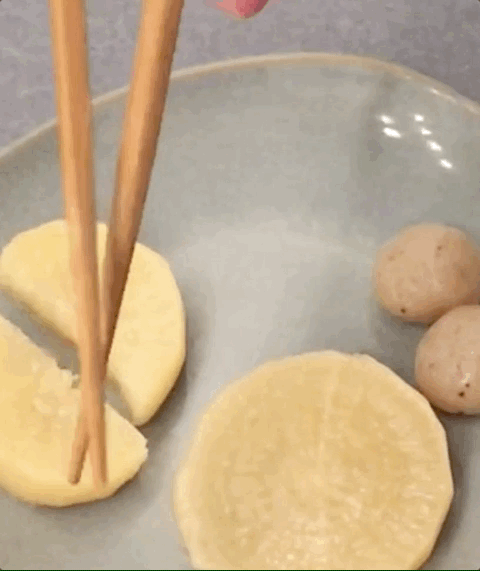
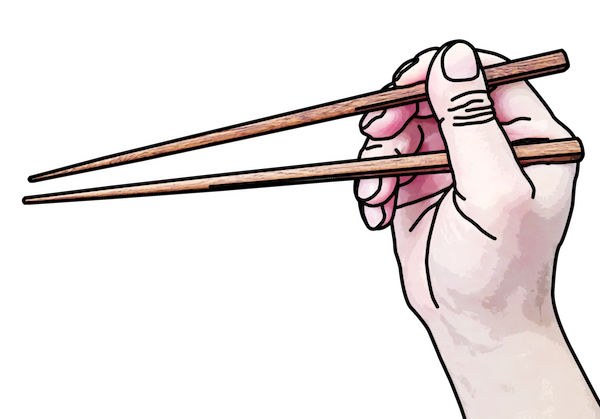
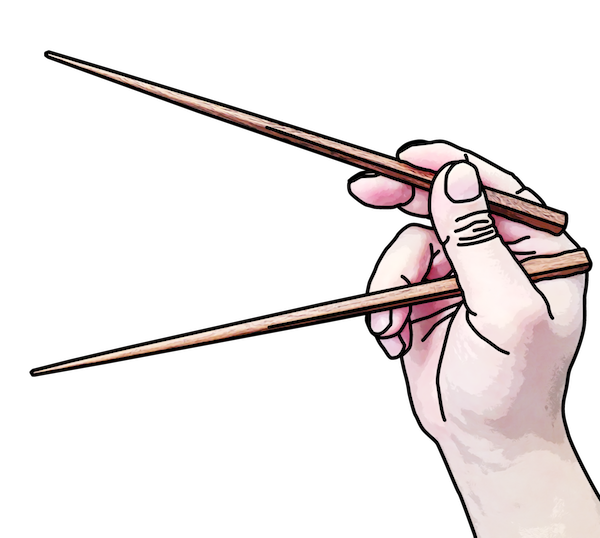

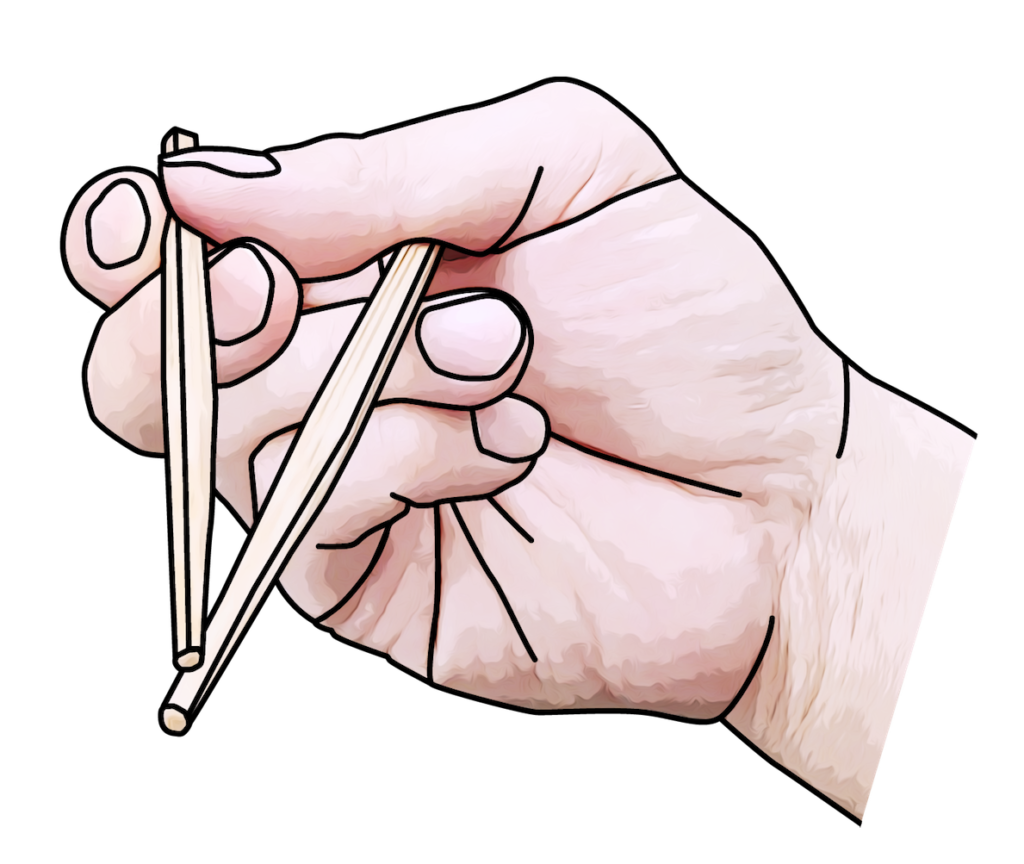
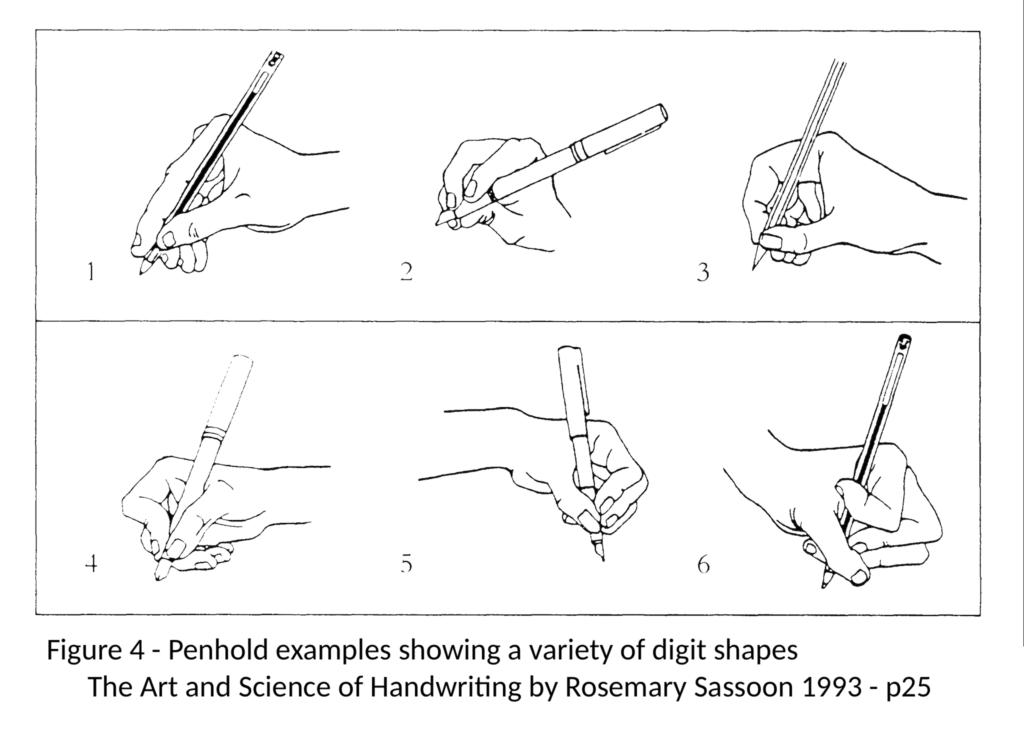
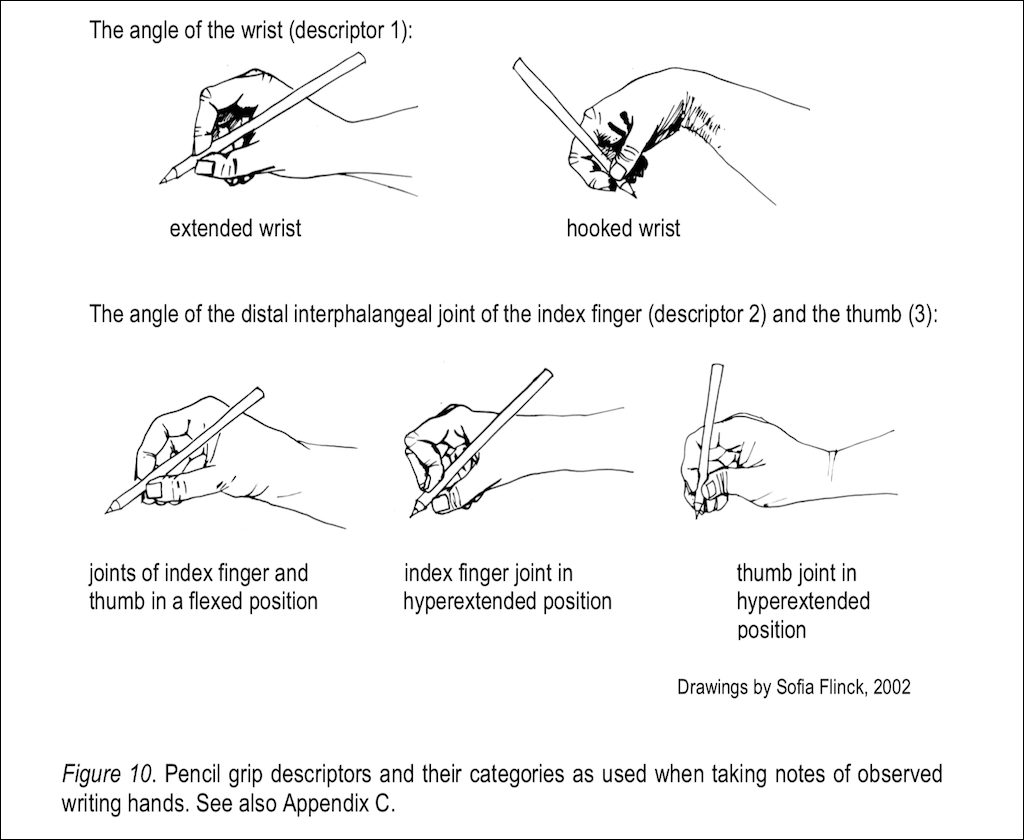

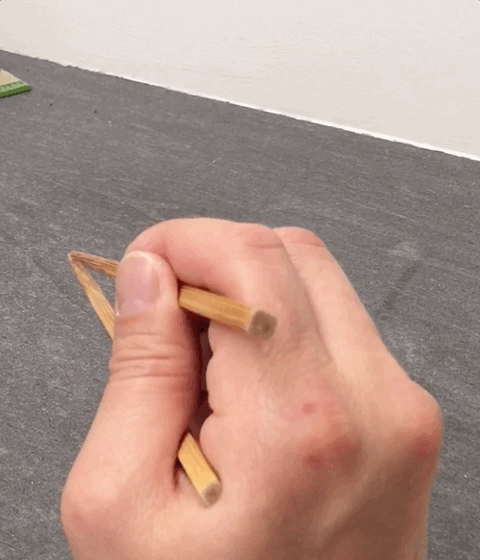


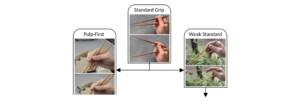

This website is awesome, beautiful and easiest to read. I really amazed. Thank you!
However, the reason I came here is looking for “the origin of the standard grip of chopsticks”.
In Japan, the topic of the standard grips becomes quite huge fight on internet. Specially because people usually consider this as “your mom’s education”, people are sensitive and gets seriously upset. There are 2~3 big discussion every year about this.
I had another fight right now and one guy said “Sure, chopsticks have 5,000 years history. But how about the way to hold them? No one can tell that. It might be modern made-up bullshit” with showing some Japanese Ukiyo-e drawings of citizens holding chopsticks non-standard grips.
I know it is difficult to tell the history since there are ancient chopsticks left we can find but no way to tell how those were handled.
Do you have any knowledge about the history of the standard (or any other) grips?
Thank you for your feedback. And we are quite aware of how serious the “proper way to hold chopsticks” is, in Japan. There are chopstick grip correction societies in Japan. In fact, 榊原 安英 (Dr. Yasuhide Sakakibara) from 国際箸学会 once helped us name, in Japanese, grips we documented. We believe that his associates did not approve of him even naming “incorrect grips” with us, and told him to stop. Those names can be found here: https://marcosticks.org/ten-thousand-ways/.
To answer your question about the “origin of the standard grip”. No, we are not aware of, and have not found any real historical accounting of how chopsticks were supposed to be griped, and more importantly, moved between the closed posture and the open posture. You will not find it. And this surely is absurd. For something which a large number of people have debated in their life, no one has bothered to actually study its finger dynamics, and write down exactly how it works.
We came to this incredible conclusion after an extensive research to find written descriptions of “chopsticking”. And that is why this website exists – we decided to be the first people to study and document chopsticking. Even today, this website is the only place in the whole world with real videos, pictures and written documentation of chopstick grips.
I caution about using historical drawings to infer how people used them, at that time. Drawing a hand wielding chopsticks is very difficult. We know this – we drew all drawings you see here. All drawings are made from manual tracing of real pictures from real videos of people using chopsticks. That is why they look real, and are accurate. Most drawings you find today or from the past of chopsticking are usually simplifications and/or artistic imaginations.
Nonetheless, we do believe that people have used dozens of different ways to hold chopsticks since thousands of years ago. We do believe that a sizable population have been using what we describe here as Standard Grip, since time immemorial. That is because this grip is the “most balanced” grip, in our measured opinion, after studying and analyzing dozens of real-life grips. But in the process we also found that, 1) the majority of chopstick users use grips other than Standard Grip, 2) a large percent of people are “unable” to physical wield Standard Grip due to anatomical constraints in their hand – not a fault of theirs – that’s just how variety in hand builds is in human.
We now reject the notion that there is a “correct” grip, and even worse, one “incorrect grip”. There are dozens of grips that work for different people. We name the Standard Grip this way, because of all short and incomplete descriptions of chopsticking from all over the world, this grip fits best what people try to describe as the “correct” way. But even people who vehemently “correct” other people’s grip may not be wielding Standard Grip. Instead, they may be using similar-looking grips such as Idling Thumb, Turncoat, Vulcan, etc. They simply do not know any better. Again, because actual written documentation is lacking.
If you are interested, we suggest that you follow up with: https://marcosticks.org/history-of-chopstick-research/, and https://marcosticks.org/the-art-and-science-of-chopsticking/.
Cheers 🙂
Pingback: Best Learning Chopsticks - My Blog
Pingback: Finger Helpers for Training Chopsticks 3D print model – BlingOrbit
Hello and thanks for the website! Your standard grip is very close to my own. Personally I consider it is the most elegant looking position and easy to grip and use. But the major difference is the placement of my sticks is on the top pads of my finger tips. Much more comfortable and more control for me at least. I tried your way as closely I could, but I feel pain as it is compressing the sticks onto my joints and bones. Maybe I am simply not being used to it.
Also, you seem to choke your grip closer to the business end, thereby your open position is not fully wide open as it could be. I hold my sticks on the far end as much as possible to have the widest open position. The way I hold mine, the end of the sticks will never cross and hardly ever goes past my hand… the top stick sticks out just a bit but ends right above my index knuckle. The bottom stick ends right at the end of my back hand. I favor the top stick to overhang on the business end just a bit over the lower stick as a slight “overbite”.
The sticks I use is standard 4 sided for my hand, the end is completely round. The business end is a stump, no tapering into a point. Wood or bamboo is my preference, I despise plastic since it is slippery, but I understand the need for restaurant use for being more sanitary. Metal is nifty looking, but it may transfer cold or heat, no thanks. Natural wood is the way to go.
Also, I get more power and clamping force to use the sticks on my fingertips as opposed to having the sticks on the side of the fingers. Therefore I can lift heavy bones such as oxtails and beef ribs with confidence and precision. The way I reason is I pinch with my fingertips on items such as clay or dough that I need to grip as I never grip or pinch on the side of my fingers, it is true when I hold my chopsticks. It is a direct correlation and that makes sense to me.
But to each their own.
Check out the explanation about how fingers user the principles of planetary gear train to exert power on sticks. And see if that helps explain some of what you were describing. Do you feel that you are twirling the top stick, using your fingertips? Do you roll the top stick as you extend tips apart? See: https://marcosticks.org/learn-to-twirl-marcosticks/
Hey, my friend, you should consider send us pictures and videos of your grip. We can discuss offline the differences, and update our articles. We may even write additional articles to discuss the merits of gripping stick surfaces with the top parts of fingertips.
On where along the length of sticks to grip them, I think that deserves an article of its own. We recently wrote about “pen grips vs. stick grips”, after offline discussion with a few folks on Reddit. We are ready to talk about this “closer or further away from the business end” topic now 🙂